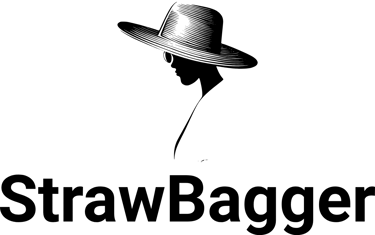Adopt a "strawbagger mindset!"

Bamboo Linen
Bamboo linen is produced through a mechanical process that crushes the woody parts of the bamboo plant, extracting the fibers without the use of harmful chemicals. This method preserves the natural integrity of the bamboo fibers, resulting in a fabric that is both eco-friendly and durable.
Benefits:
Sustainable Source: Bamboo grows rapidly without the need for pesticides or fertilizers.
Eco-Friendly Production: Mechanical processing avoids harmful chemicals, making it environmentally friendly.
Breathable and Moisture-Wicking: Keeps the wearer comfortable in various climates.
Biodegradable: Naturally decomposes, reducing environmental impact.
Source: (Verdine Daniels)
Uses:
Clothing items like shirts and dresses.
Home textiles such as bed linens and towels.
Accessories, including scarves and wraps.
Source: (Knowing Fabric)
Bamboo Linen: Its Benefits and Uses
Let's take a Closer Look at Bamboo Linen
Bamboo Linen as a Sustainable Fabric
1. What is Bamboo Linen?
Bamboo linen (also called mechanically processed bamboo fabric) is made by mechanically crushing bamboo stalks and then using natural enzymes to break down the fibers, which are combed and spun into yarn — a process similar to traditional linen production from flax.
This is distinct from bamboo viscose/rayon, which involves heavy chemical processing. Bamboo linen is the more eco-friendly, less chemically intensive alternative.
It is sometimes referred to as bamboo flax or bamboo bast fiber, and though it’s more labor-intensive to produce, it retains the natural strength and sustainability of both bamboo and traditional linen.
2. Environmental Benefits
Fast-Growing & Renewable: Bamboo is one of the fastest-growing plants on Earth, capable of growing up to 3 feet per day without the need for pesticides or fertilizers.
Low Water Footprint: Bamboo thrives with little irrigation, often requiring no more than rainwater — especially compared to thirsty crops like cotton.
Carbon Sequestration: Bamboo absorbs large amounts of carbon dioxide and releases more oxygen than an equivalent stand of trees, making it a carbon-negative resource when cultivated responsibly.
Minimal Land Use: Bamboo yields more fiber per acre than cotton or flax, making it a more land-efficient crop for textile production.
Biodegradability: Bamboo linen is fully biodegradable under composting conditions, breaking down without leaving behind toxic residues or microplastics.
3. Durability and Longevity
Bamboo linen fibers are strong and long-lasting, making them ideal for high-wear items.
Like traditional linen, bamboo linen gets softer with each wash without losing its structural integrity.
It resists pilling and maintains its shape well over time, contributing to a lower turnover in clothing and home textiles.
4. Low-Waste Production
The mechanical process used in making bamboo linen is low-impact and generates less water and chemical waste compared to the production of bamboo viscose.
Almost every part of the bamboo plant can be utilized: fibers for textiles, shoots for food, and remaining materials for paper, biomass, or construction.
Waste from fiber production is minimal and often biodegradable or reusable in other applications.
5. Versatility and Comfort
Bamboo linen is naturally breathable, with moisture-wicking and temperature-regulating properties, making it ideal for sensitive skin or warm climates.
It offers a silky texture with a slight crispness, combining the softness of bamboo with the structured feel of linen.
It is hypoallergenic and antimicrobial, helping to resist odors and bacteria buildup — a great feature for bed linens, towels, and activewear.
Suitable applications include:
Clothing (especially summer wear, undergarments, loungewear)
Home textiles (bedding, towels, curtains)
Eco-friendly accessories (reusable wipes, diapers, etc.)
6. Economic and Social Impact
Bamboo can be cultivated in degraded or marginal lands, offering income opportunities in regions unsuitable for traditional agriculture.
When sourced from responsibly managed farms, bamboo cultivation supports rural economies and often requires less labor than conventional cotton farming.
Mechanically processed bamboo requires skilled labor and artisanal knowledge, which can support specialized jobs in sustainable fashion supply chains.
7. Circular Fashion and Bamboo Linen
The long life cycle and compostability of bamboo linen make it an excellent fit for circular fashion principles:
Designed to last
Easy to recycle or compost at end-of-life
Non-toxic and safe for natural systems
Its durability also allows for reuse and resale in secondhand markets, reducing the need for virgin textile production.
8. Things to Consider
Not All Bamboo Fabrics Are Equal: Bamboo viscose, though labeled “bamboo,” is often produced with harmful chemicals. Always verify the processing method (look for “mechanically processed bamboo” or “bamboo linen”).
Cost and Availability: Bamboo linen is more labor-intensive to produce and less widely available, so it may carry a higher price tag than cotton or viscose alternatives.
Certifications Matter: Look for eco-certifications like OEKO-TEX®, GOTS, or FSC (for bamboo sourcing) to ensure environmental and ethical integrity.
Limited Transparency: Some bamboo products lack traceability in the supply chain — supporting transparent, certified brands is key.
